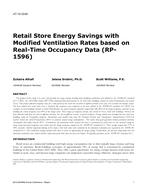Description
The purpose of this study is to assess and quantify the energy savings resulting from modifying ventilation rates defined by the ASHRAE standard 62.1 (VRP). An ASHRAE project (RP-1596) conducted field measurements in 14 retail stores buildings, located in central Pennsylvania and central Texas. This project collected occupancy data for a time period of one week that occurred in different periods of the year, but excluded the holiday season. The data showed that retail stores have a relatively low occupancy rates compared to the rates defined in the ASHRAE standard 62.1-2010. For example, in retail buildings located in central Pennsylvania, the actual occupancy typically ranged from 30 to 40% of the design occupancy and only in one building the actual occupancy was 60% of the design value. These ranges of occupancy density also existed in Texas retail store buildings. Overall, the data collection took place not only in different locations, but also in different seasons, except the holidays. Energy models were developed for two retail store buildings using the EnergyPlus program. Simulations used weather data from the National Oceanic and Atmospheric Administration (NOAA) weather station for central Pennsylvania (2011) to calculate annual energy consumptions. The results show good agreement between predicted electricity consumption and utility bills for 2011. Furthermore, the simulation results showed that there is a potential for retail stores to save electrical energy by using actual measured occupancy rates rather than the design occupancy requited by the ASHRAE standard 62.1. These savings ranged from 17% to 38% annually. Another important finding of this study is that both stores were ventilated by the minimum ventilation rate required by the ASHRAE Standard 62.1. This ventilation strategy enabled both stores to create an opportunity for energy savings. Furthermore, our previous study found that the minimum ventilation rates could be further safely lowered for both stores based on the Indoor Air Quality procedures of the ASHRAE Standard 62.1.
Product Details
- Published:
- 2015
- Number of Pages:
- 7
- Units of Measure:
- Dual
- File Size:
- 1 file , 2 MB
- Product Code(s):
- D-AT-15-C049
- Note:
- This product is unavailable in Russia, Belarus




